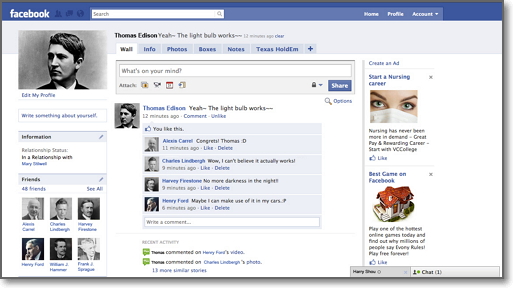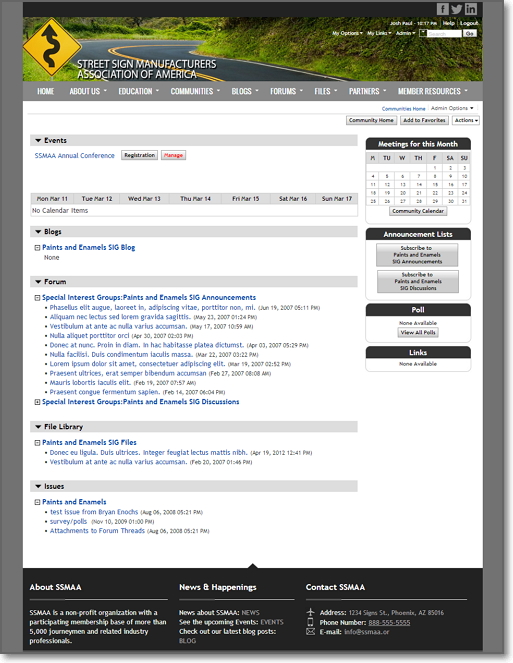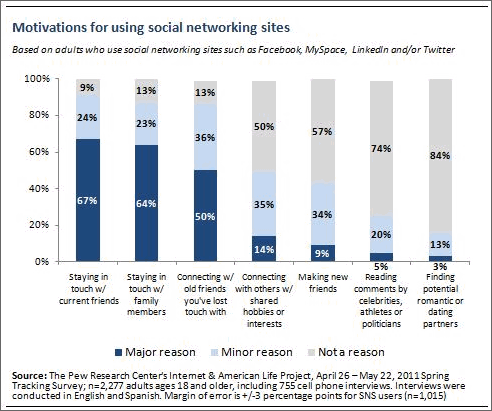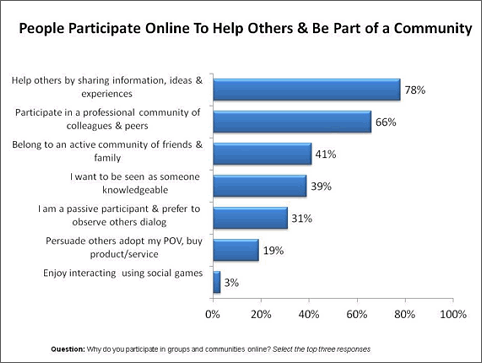When you’ve been providing online community software for as long as we have at Socious, there are certain things that people say when you are initially talking to them or during their buying process that indicate where their mind is and the sophistication of their thinking around online communities.
In one common example, when we discuss their strategy and how the organization plans on incorporating the online member or customer community into its overall strategy, the question-asker becomes a little flustered in describing the business problems they are trying to solve and just says, “We want something like Facebook for our customers,” or “We want a private Facebook for our members.”
Due to much larger levels of online and offline media coverage for public social networks compared with private online communities, these parallels and questions are perfectly understandable. People point out the most prominent feature of a public social network, the “wall” or news feed, and ask, “Can you give us something like that?”
This post explores the implications of focusing on social networking-type features like a “wall” and how incorporating a “wall” into your online customer or member community might impact your results. There is a science behind creating thriving online communities and there is a lot of data as to what makes an online community successful and what does not.
Social Networks vs. Online Communities
Social networks are not online communities. Sure, they share several common traits. They both exist online, they are places where people discover content and other people, and they both fall within the blurry lines that define social business platforms. However, it is important for business people to recognize the major differences between social networks and online communities.
Social Networks: Individual People or Companies
Social network platforms, first and foremost, encourage connections and interactions between people.
Online Communities: Shared Interests, Goals, and Values
Online communities focus on bringing people together around interests, professions, products, and causes.
This brings us back to one very important distinction – the “wall” vs. the group.
Does Your Online Community Need “Walls” or Groups?
In social networks, the “wall” is the central news feed that displays a chronological listing of updates and messages from the people and organizations that you follow. For instance, when you log into Facebook, you see the photos from your cousin’s wedding, a new sale at your favorite clothing store, and a message from your best friend asking about getting together next weekend.
Like the offline communities that we live in, online communities are not built primarily around individual connections. While it is true we have our own networks in our offline lives, communities and movements are built around shared interested and values. Offline, we build communities around hobbies, jobs, our kids’ schools, churches, volunteer organizations, and other interests.
For this reason, online communities, whether they are online customer communities for companies and online member communities for nonprofit organizations, focus on niche online groups more than they focus on “walls” for each individual member of the community.
In online communities, customers or members have access to specific groups based on things like their status in the organization (i.e. customer advisory board member), product segment or membership type (i.e. student members), or individual interest (i.e. an international issues group).
Individualism vs. Common Goals
Social networks run on individualism. Facebook even thrives when the number of users decreases. Since social networks are based on many-to-many connections, they are not as exposed to the rules of the “chicken and the egg model of online community success.” This rule that says that:
Customers or members need to use your community in order for others to see it as a benefit of doing business with you (or of membership). And people need to see it as a benefit of doing business with you (or of membership) so that they use it.
A majority of people that belong to a public or private social network could ignore it for a few months and the social network would still endure because the individual connections are still intact.
Communities, on the other hand, need activity to survive. They need members of the community to start discussions and respond to discussions. The need people to create content and then they need others to comment on, rank, and share that content.
If online customer or member communities were structured in the way that social networks are, each individual would have to connect with every other individual to stay up on, and participate in, conversations on each other’s “walls” pertaining the entire community or their specific segment of the community.
It Comes Down to Where the Action Happens
Online communities still have activity feeds where you can see updates from the people that you follow. They still have “favorites” features and personalized alerts so that you can get custom views of the topics, groups, and discussions that you are interested in when you login or open your email. You can still track content, discussions, and people of interest in online communities.
Members of an online community can stay just as connected as they can in a social network. However, in online communities, that action happens in groups rather than on individual “walls.”
This is not to say that individual customers and members can’t connect or contact one another in online communities. The difference is that the focus is not on individual “walls.” It is on group discussions, file-sharing, and collaboration over products and issues.
Online Communities vs. Social Networks: People Use Them Differently
Think about why people use social networks. According to a Pew Research Center’s 2011 report, people mainly use social networks to stay in touch with friends and family. The “wall” or news feed-style set up of many major social networks fit well with this by putting the emphasis on personal connections.
Now, think about why people use private online communities. They are seeking answers, helping others, and just “belonging” to a community of peers.
In a 2012 study by the Society of New Communications Research (SNCR), called The Social Mind, research indicates that nearly 80% of people belong to private online communities to “help others by sharing information, ideas, and experience.” 66% of the respondents to the study said that they are members of online communities in order to “participate in a professional community of colleagues and peers.”
Both the reasons that people use social networks and the reasons that people participate in online communities are valid. However, the core structure and differences between the two make each a strong fit for the way that people use them.
Are “Walls” or Groups Better for Social Density and Why Does It Matter?
Online Communities need to maintain a high degree of social density to succeed both initially and over time. Social density is the measure by which activity is concentrated in the community.
According to top online community consultant and educator, Richard Millington:
“If your social density is too low (i.e. you spread the same level of interactions over too many places to host them, such as forum categories, chat rooms, status updates, twitter etc…) the community feels empty. It takes longer to get a response to your posts. Members get bored and leave.”
If activity begets activity and spreading activity across members’ individual “walls” can lead to serious tactical problems in your community, then it makes sense to focus everyone’s updates, comments, and content into only a few areas to make it clear to everyone in the community where the action and value are.
If your community is in its initial stages or is seeing a slowdown in activity, avoid providing too many places where people can participate. Spreading out the areas where community members can get in on the activity dilutes the social density of your community. Members will see less activity in any given groups.
Note: This is why companies and membership organizations avoid letting customers or members create their own groups. Instead, they opt for groups set up by the sponsoring organization’s community management team. When you have multiple member-created groups for the same topic, they cannibalize each other. The result? Members see less activity, which leads to less participation by those members.
Social Networks That Focus on “Walls” Might Not Make Strong Communities
Organizations that use a “wall-based” social network structure for their online community, where discussions are occurring on individual members’ personal news feed (“walls”), can seriously dilute the social density of the online groups that focus on issues, product segments, and other important topics. The way that “walls” fracture where customers or members see activity can seriously threaten the health, productivity, and long-term viability of your online community.
Why Online Communities Need Groups, Not “Walls”
Both online communities based on group collaboration and social networks predicated on individual “walls” are valuable. However, they serve very different purposes and fit very different business situations.
Private online communities, also known as communities of interest (built around shared causes, hobbies, etc.) or communities of practice (built around shared industries, professions, product usage, etc.), are fueled by activity in groups around the niche topics.
On the flip side, as I explained above, the success of social networks is driven by individual connections. Our inclination toward individualism is the reason that public social networks, like Facebook and LinkedIn, thrive. It is also the reason Facebook’s groups feature didn’t work and most LinkedIn groups are ineffective.
You need the shared mission of the community and the focus on sharing with, helping, and believing in the community to be front and center in customers’ or members’ minds. “Walls” on social networks are not nearly as capable of fostering this approach as online groups.
When Should You Implement a “Wall?”
Aside from public social networks, “wall” features are sometimes a good complement to an internal employee community or a social intranet solution. Individuals can quickly see updates from the people they work with without sifting through the noise of the entire organization’s daily project updates.
However, online customer communities and online member communities demand online communities, not social networks. The focus on individual “walls” not only instills the wrong culture in the community, but it can seriously delay or derail the value that the community delivers to your organization and its members.
Takeaway for Selecting an Online Community Software Platform
Are you creating a social network or an online community?
In the same way that it would be difficult to use an online community group-based model to stay connected to friends, family, and others in your network, employing a “wall-oriented” social network model to communities of practice, communities of interest, and other peer-to-peer customer or member communities would be detrimental to the success of the community.
This article is not meant to push one approach over the other in all cases. Positioning “wall-type” news feeds at the center of your social network can be the right decision. If the purpose of your social business strategy is to primarily foster individual relationships, “walls” come with a lot of benefits.
If you are trying to bring customers or members together to support a product, rally around a cause, or take a collective action, focusing on groups in your online community makes much more sense.
Your Turn…
Please add your thoughts and experiences with online community groups and social networking “walls” in the comments below.



